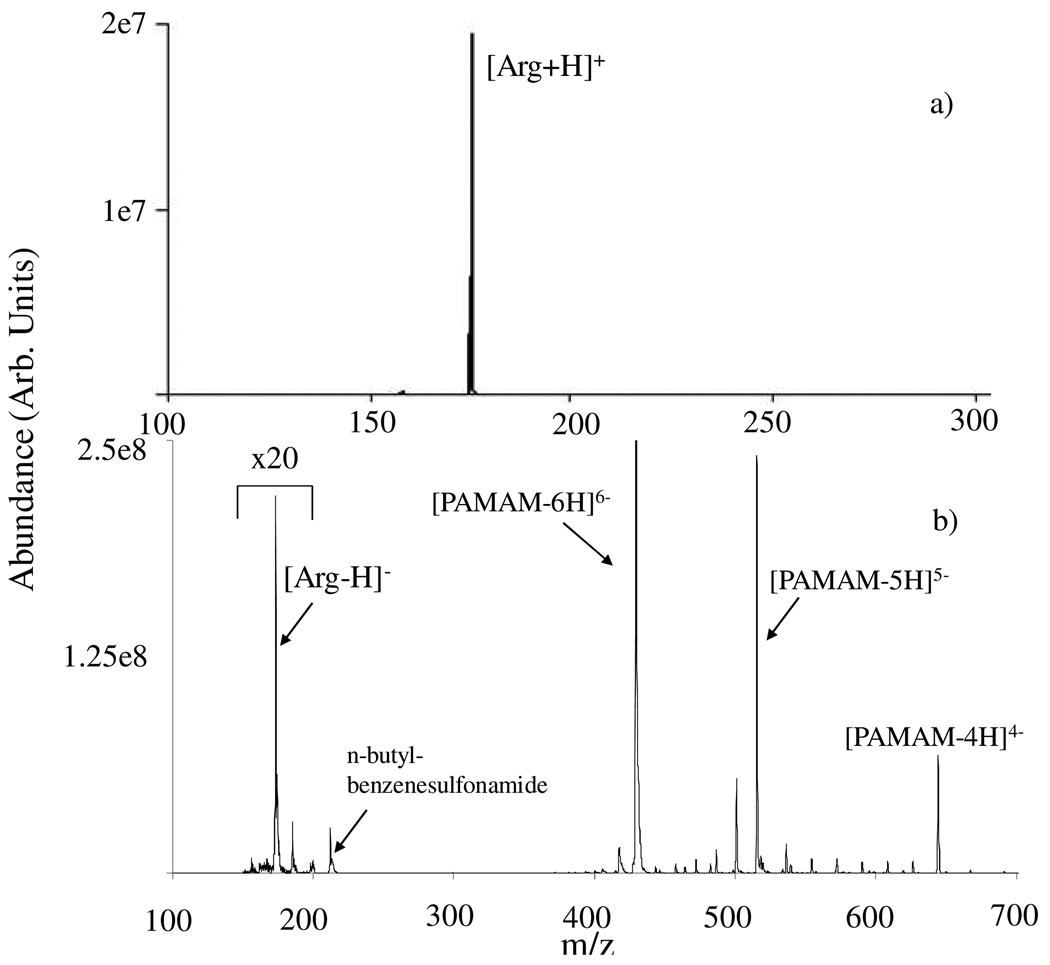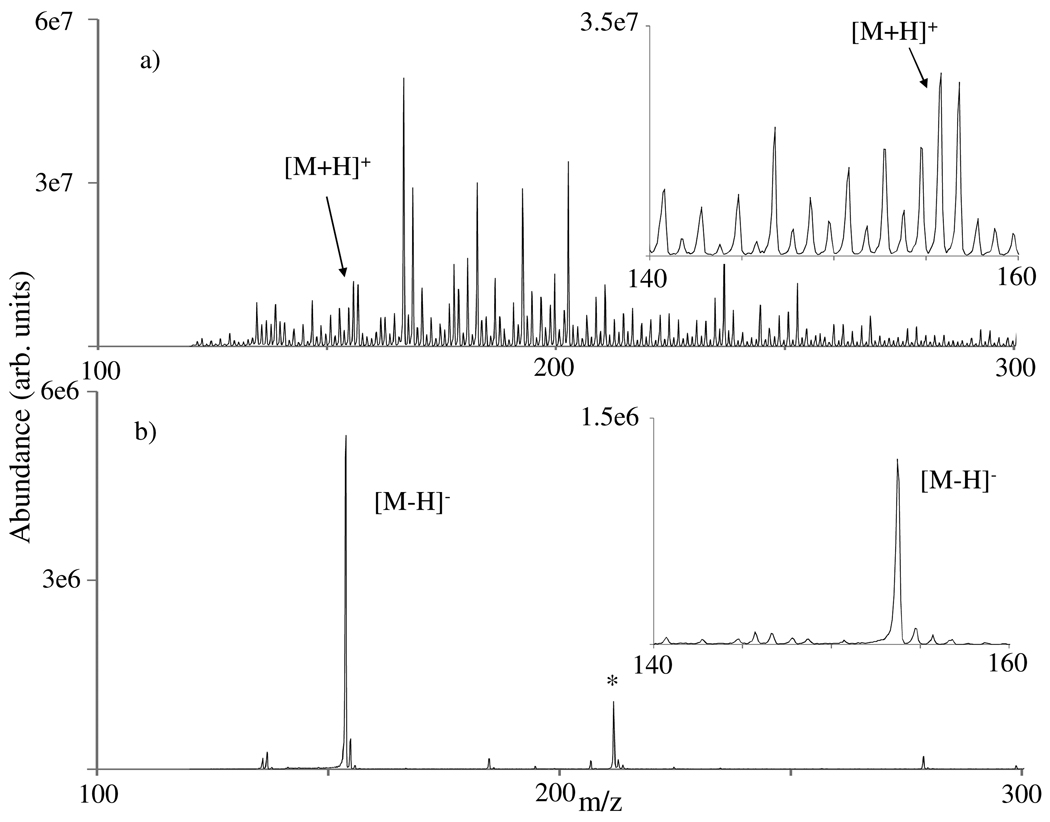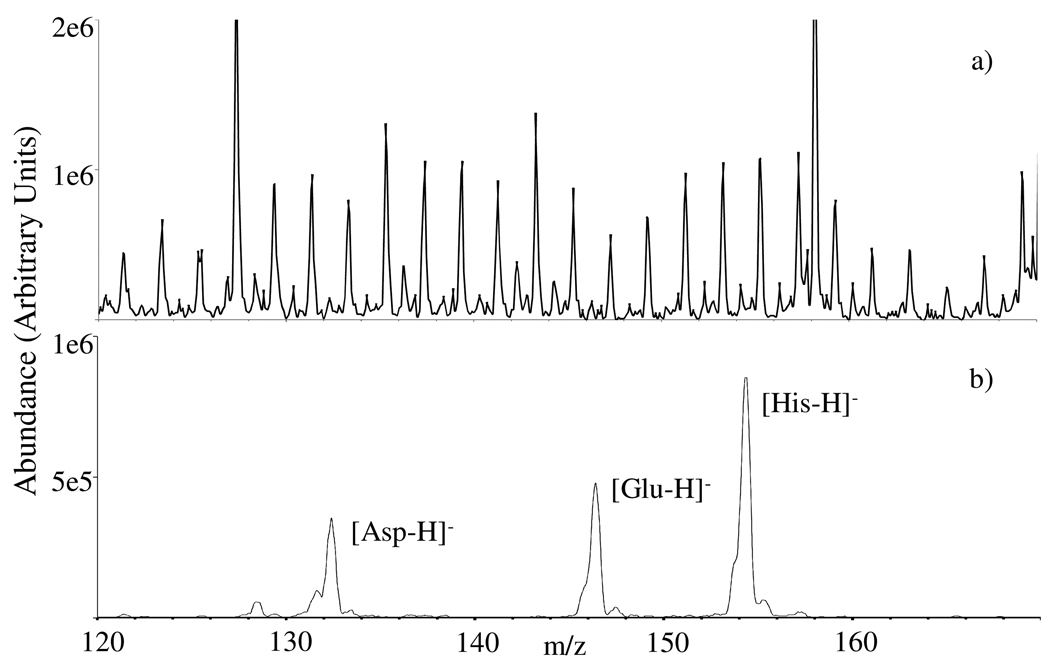Abstract
Charge inversion ion/ion reactions can provide a significant reduction in chemical noise associated with mass spectra derived from complex mixtures for species comprised of both acidic and basic sites, provided the ions derived from the matrix largely undergo neutralization. Amino acids constitute an important class of amphoteric compounds that undergo relatively efficient charge inversion. Precipitated plasma constitutes a relatively complex biological matrix that yields detectable signals at essentially every mass-to-charge value over a wide range. This chemical noise can be dramatically reduced by using multiply-charged reagent ions that can invert the charge of species amenable to the transfer of multiple charges upon a single interaction and by detecting product ions of opposite polarity. The principle is illustrated here with amino acids present in precipitated plasma subjected to ionization in the positive mode, reaction with anions derived from negative nano-electrospray ionization of poly (amido amine) dendrimer generation 3.5, and mass analysis in the negative ion mode.
Keywords: Amino acid, charge inversion, plasma, ion/ion reactions
Introduction
Complex mixture analysis has long occupied analytical chemists. Modern mixture analysis problems that represent areas of high activity in the research community include the various ‘omics’ measurements, such as proteomics, metabolomics, lipidomics, etc., which require high informing powers to deal with mixture complexity. Mass spectrometry, in one or more of its various forms, plays an important role in many of these areas due to its wide applicability, high specificity, and generally high sensitivities and informing powers. Detection limits in the mass spectrometry of complex mixtures are generally limited by ‘chemical noise’1, 2, which can be regarded as signals derived from components in the sample that are indistinguishable from the signal generated by the analyte of interest. A common measure for minimizing chemical noise in mass spectrometry, as well as to minimize matrix effects on ionization, is to subject the mixture to separation, either on-line or off-line, prior to the ionization step. Nevertheless, even when separations are used, signals due to chemical noise from complex mixtures are often present at levels that are orders of magnitude greater than, for example, electronic noise. A very powerful approach for discrimination against chemical noise is tandem mass spectrometry or mass spectrometry/mass spectrometry (MS/MS) that employs specific fragmentation transitions to distinguish analyte ions from ions that comprise the chemical noise3. The combination of on-line separations with MS/MS constitutes a very powerful approach for achieving the lowest obtainable detection limits in many complex mixture analysis scenarios. In this work, we illustrate the use of ion/ion charge inversion reactions4 as means for discrimination against chemical noise in favorable scenarios. The reactions can be used between ionization and mass analysis (i.e., no tandem mass spectrometry) or within the context of tandem mass spectrometry experiment.
Gas-phase ion/ion reactions have been shown to be useful in a number of analytical applications involving electrospray ionization (ESI)5. For example, proton transfer reactions have been used for mixture analysis6,7, for the facilitation of product ion charge state determination from dissociation of multiply-charged precursor ions8, and for the concentration of signal dispersed over multiple charge states into a single charge state9, while electron transfer reactions have been used as a dissociation method (i.e., electron transfer dissociation)10. In the applications just mentioned, the analyte ion is multiply-charged while the reagent ion is singly-charged. It is also possible to employ ion/ion reactions with singly-charged analyte species provided the reagent ions are multiply-charged and that the analyte ion undergoes a change in polarity (i.e., it is not neutralized). This charge inversion of the analyte ion via ion/ion reactions is a type of charge permutation reaction that occurs at low relative translational energies11. Initial studies involving ion/ion charge transfer were focused on increasing the absolute charges of ions via sequential charge inversion reactions4,12. The concept for chemical noise reduction in a complex mixture analysis scenario via gas-phase ion/ion charge inversion reactions is illustrated here with amino acids. Free amino acid levels are indicators of various metabolic processes13 and can indicate metabolic disorder14. They can be used, for example, as biomarkers in biological fluids, such as plasma, for cancer diagnosis15,16. They are excellent candidates for charge inversion due to their amphiprotic nature (i.e., they all possess a basic N-terminus and an acidic C-terminus). Discrimination is illustrated here with amino acids present in precipitated blood plasma.
Experimental
Materials
Amino acids, poly(amido amine) (PAMAM) generations 1.5 and 3.5 (carboxy terminated dendrimers), PAMAM-NH2 generation 3 (amino terminated dendrimer), and cytochrome c were purchased from Sigma Aldrich (St. Louis, MO) and were dissolved in water to concentrations of ~1 mg/mL. Precipitated plasma was diluted five times in a 50/50 water-methanol, 5 mM ammonium acetate, and 0.1% acetic acid solution. Ammonium hydroxide and acetic acid were obtained from Malinckrodt (Mallinckrodt, Phillipsburg, NJ).
Mass Spectrometry
Experiments were all performed on hybrid triple quadrupole/linear ion trap tandem mass spectrometers17 (either a QTRAP 2000 or QTRAP 4000, AB SCIEX, Concord, ON, Canada) that have been modified for ion/ion reactions.18 A home-made dual pulsed nano-ESI (nESI) arrangement allows for the sequential injection and subsequent reaction of oppositely charged.19 Daetalyst 3.14, a research version of software developed by AB SCIEX, allowed for independent triggering of each ion source and provided control of lens potentials for introduction of oppositely charged ions into the mass spectrometer. Details of charge inversion experiments in instruments of this geometry have been previously described.20,21
The instruments consist of four in-line quadrupole arrays designated as Q0–Q3. A charge inversion ion/ion reaction experiment proceeds as follows: transmission of reagent ions produced via nESI through Q0 and Q1 (where ions within a narrow band of m/z values is selected) and into the Q2 array. The reagent ions are cooled in Q2, which is held at a pressure of 6–8 mTorr. The analyte ions are injected and isolated by Q1 in mass resolving mode while being transmitted into Q2 where mutual storage takes place. The opposite polarity ions were allowed to interact in the Q2 collisional cell for several hundred milliseconds. Following the ion/ion reaction, the product ions were transferred to the mass analyzing Q3, which operates at 1–10×10−5 torr range, for mass analysis via mass selective axial ejection (MSAE).22 28
Results and Discussion
The basis for discrimination against chemical noise by either dissociation or ion/ion reactions is via differences in the chemistries of ions derived from the analyte versus those derived from the chemical noise. In the case of dissociation, for example, the analyte species is expected to show unique fragment ions. In the case of ion/ion charge inversion, discrimination occurs when the analyte ion undergoes charge inversion while most or all of the ions derived from chemical noise undergo neutralization. This competition is represented for singly protonated analyte species, M, in reaction with multiply-deprotonated reagent, R, by reactions (1) (charge inversion) and (2) (neutralization).
| (1) |
| (2) |
This work emphasizes proton transfer as the main charge transfer reaction as this process dominates for amino acids. However, charge inversion reactions involving metal ion transfer in conjunction with proton transfer,23 anion transfer in conjunction with cation transfer,24 and covalent attachment of a reagent ion25 have also been noted. The chemical properties of the analyte and reagent ions determine the dominant pathways for reaction. The use of multiply-protonated or multiply-deprotonated reagents maximizes the likelihood for formation of either (M+H)+ or (M−H)− ions, respectively, as the final analyte charge inversion product. We have commonly used either half-generation PAMAM dendrimer ions, which are terminated in carboxyl groups, as anionic reagents for charge inversion or full generation PAMAM dendrimer ions, which are terminated in amino groups, as cationic charge inversion reagents. Negative-to-positive charge inversion of amino acids has also been studied (see Figure S-1 for an example) but is not emphasized here. Charge inversion in either direction is generally equally facile with reagent ions optimized for generation and charge state.
Some of the basic phenomenology noted for positive-to-negative charge inversion that is common to the twenty or so amino acids thus far examined is illustrated by the data in Figure 1. Figure 1(a) shows the mass-selected protonated arginine signal (a broad isolation window was used) in the positive ion mode while Figure 1(b) shows the resulting negative ion spectrum when the ions of Figure 1(a) were subjected to reaction with generation 1.5 [PAMAM-6H]6− ions. The appearance of deprotonated arginine in Figure 1(b) indicates that at least some of the arginine cations underwent the transfer of two protons upon reaction with the reagent anion. The appearance of [PAMAM-5H]5− indicates that some of the protonated arginine ions underwent single proton transfer and were therefore neutralized. Note that a significant fraction of the [PAMAM-5H]5− signal arises from ion/molecule proton transfer involving adventitious species present in the ion trap. For example, a relatively high mass species is n-butylbenzenesulfonamide, a plasticizer, which is indicated in Figure 1(b), appears as the deprotonated molecule. Outgassing from electronics components mounted in the vacuum system is the major source of these products.
Figure 1.
Charge inverted arginine from positive to negative reacting with PAMAM 1.5 isolated [PAMAM-6H]6− charge state. (a) cation only spectrum of arginine, and (b) charge inverted spectrum of arginine. The small peaks between the main PAMAM charge states arise from PAMAM fragment ions. The small peaks near deprotonated arginine may also arise from the PAMAM anions but more likely arise from charge inversion of low level species present in the broad isolation window used for the cations.
Cations derived from positive nESI of a roughly equimolar mixture of over a dozen amino acids was simultaneously subjected to charge inversion with a mixture of multiply charged anions derived from PAMAM generation 3.5. The results for this experiment are provided as supplementary information in Figure S-2. All of the amino acid cations were found to undergo charge inversion. Some variation in relative abundances between the positive and negative ion data is noted, presumably due to differences in charge inversion efficiencies for the various amino acids. However, the data indicate that the efficiencies are all likely to be within an order of magnitude of one another. This is consistent with measurement of the ratios of signal levels for the [M−H]− ions after charge inversion relative to the [M+H]+ signals prior to charge inversion for a variety of amino acid cations subjected to reaction with [PAMAM-6H]6− derived from generation 1.5 (see Figure S-3). While it is not possible to assess the absolute charge inversion efficiencies due to possible differences in detection efficiencies for positive versus negative ions, it is possible to determine an ‘operational’ efficiency, defined as the percentage of the positive ion signal depleted by reaction that is converted to negative ion signal, i.e.,
| (3) |
where Σ[M−H]− is the analyte anions signal after charge inversion, Σ[M+H]+i is the initial cation signal prior to reaction, and Σ[M+H]+f is any residual cation signal after reaction. Operational efficiencies under optimal ion storage conditions are found to be as high as several tens of percent with the generation 1.5 [PAMAM-6H]6− anions (see Figure S-3).
The reduction of chemical noise afforded by the use of ion/ion charge inversion is illustrated in Figure 2, which compares the positive nESI mass spectrum of a precipitated plasma solution spiked with 100 µM histidine prior to ion/ion reaction (Figure 2(a)) with the negative ion spectrum obtained after ion/ion reaction with anions derived from PAMAM generation 3.5 dendrimers within the m/z window of roughly 557–567. The inserts in the figure highlight the regions where the amino acid ions appear. The positive ion spectrum is obviously chemically noisy but a large majority of the peaks noted in the positive ion spectrum essentially disappear upon charge inversion, indicating that the ions in the matrix that generate these signals predominantly undergo reaction (2) (i.e., they are neutralized) while a substantial fraction of the amino acid cation undergoes reaction (1) (i.e., two proton transfer reactions to yield the [M−H]− ion). The signal-to-noise ratio for histidine ions is transformed from <2 in Figure 2(a) to >200 in Figure 2(b). Data were collected as a function of histidine concentration over a range of 10 µM-1 mM. A linear response up to 800 µM was noted (see Figure S-4) with evidence for non-linearity at higher concentrations. This could arise from the limited charging capacity of nESI or, more likely, from consumption of the reagent anions at high cation levels sufficient to alter the fraction of cations converted to anions.
Figure 2.
(a) Positive nESI mass spectrum of a precipitated plasma solution spiked with 100 µM histidine. (b) negative ion spectrum obtained after ion/ion reaction with generation 1.5 [PAMAM-6H]6− reagent anions. The peak indicated with an asterisk (*) arises from n-benzenesulfonamide.
An attractive aspect of charge inversion reactions for chemical noise reduction is that they can be applied to a mixture of analyte ions simultaneously (i.e., after ionization and before mass analysis, see also Figure S-2). This allows for the simultaneous determination of multiple analyte ions. In contrast, the use of MS/MS requires multiple analyte ions to be examined in series. Figure 3 provides an illustration of the application of charge inversion to a mixture of amino acids in a complex matrix by comparing the pre-ion/ion reaction mass spectrum of a precipitated plasma solution spiked with aspartic acid, glutamic acid, and histidine (Figure 3(a)) with the negative ion mass spectrum obtained after charge inversion (Figure 3(b)). An improvement in signal-to-noise ratio for the three analytes similar to that noted in the comparison of Figure 2 (i.e., an improvement of two orders of magnitude) is noted.
Figure 3.
(a) Positive ion nESI mass spectrum of a mixture of amino acids present in a solution of precipitated plasma, and (b) negative ion mass spectrum after charge inversion using anions generated from nESI of PAMAM generation 3.5.
Conclusions
A significant reduction in chemical noise in the mass spectrometry of complex mixtures can be effected via gas-phase charge inversion reactions provided the analyte ions readily undergo charge inversion while ions derived from chemical noise predominantly undergo neutralization. Such a situation is shown to prevail in the nESI mass spectrometry of amino acids in a precipitated plasma matrix. Operational efficiencies of several tens of percent have been measured for amino acids with acidic, basic, and non-polar side-chains. Such efficiencies are competitive with highly efficient fragmentation reactions. An advantage of charge inversion over fragmentation as a means for reducing chemical noise is that the latter generally must be conducted within the context of MS/MS while the former can be applied simultaneously to a mixture of precursor ions. The two approaches, however, are not mutually exclusive. It is also possible to use charge inversion followed by fragmentation in MS/MS.
Supplementary Material
Acknowledgement
This research was supported by AB Sciex and the National Institutes of Health under Grant GM 45372.
References
- 1.Busch KL, Cooks RG. J. Chem. Educ. 1982;59:926–933. [Google Scholar]
- 2.Busch KL. Spectroscopy. 2002;17:32–37. [Google Scholar]
- 3.Kondrat RW, Cooks RG. Anal. Chem. 1978;50:81A–92A. [Google Scholar]
- 4.He M, McLuckey SA. J. Am. Chem. Soc. 2003;125:7756–7757. doi: 10.1021/ja0354521. [DOI] [PubMed] [Google Scholar]
- 5.McLuckey SA, Huang T-Y. Anal. Chem. 2009;81:8669–8676. doi: 10.1021/ac9014935. [DOI] [PMC free article] [PubMed] [Google Scholar]
- 6.Stephenson JL, Jr, McLuckey SA. Anal. Chem. 1996;68:4026–4032. doi: 10.1021/ac9605657. [DOI] [PubMed] [Google Scholar]
- 7.Scalf M, Westphall MS, Smith LM. Anal. Chem. 2000;72:52–60. doi: 10.1021/ac990878c. [DOI] [PubMed] [Google Scholar]
- 8.Stephenson JL, Jr, McLuckey SA. Anal. Chem. 1998;70:3533–3544. doi: 10.1021/ac9802832. [DOI] [PubMed] [Google Scholar]
- 9.McLuckey SA, Reid GE, Wells MJ. Anal. Chem. 2002;74:336–346. doi: 10.1021/ac0109671. [DOI] [PubMed] [Google Scholar]
- 10.Syka JEP, Coon JJ, Schroeder MJ, Shabanowitz J, Hunt DF. Proc. Natl. Acad. Sci. U.S.A. 2004;101:9528–9533. doi: 10.1073/pnas.0402700101. [DOI] [PMC free article] [PubMed] [Google Scholar]
- 11.He M, McLuckey SA. J. Mass Spectrom. 2004;39:1231–1259. doi: 10.1002/jms.629. [DOI] [PubMed] [Google Scholar]
- 12.He M, McLuckey SA. Anal. Chem. 2004;76:4189–4192. doi: 10.1021/ac496087. [DOI] [PMC free article] [PubMed] [Google Scholar]
- 13.Gu L, Jones AD, Last RL. Anal. Chem. 2007;79:8067–8075. doi: 10.1021/ac070938b. [DOI] [PubMed] [Google Scholar]
- 14.Prata CBP, Fraysse N, Treilhou M, Poinsot V, Couderc F. Electrophoresis. 2001;22:4129–4138. doi: 10.1002/1522-2683(200111)22:19<4129::AID-ELPS4129>3.0.CO;2-I. [DOI] [PubMed] [Google Scholar]
- 15.Cascino A, Muscaritoli M, Cangiano C, Conversano L, Laviano A, Ariemma S, Meguid MM, Rossi Fanelli F. Anticancer Res. 1995;15:507–510. [PubMed] [Google Scholar]
- 16.Asiago VM, Alvarado LZ, Shanaiah N, Nagado Gowda GA, Owusu-Sarfo K, Ballas R, Raftery D. Cancer Res. 2010;70:8309–8318. doi: 10.1158/0008-5472.CAN-10-1319. [DOI] [PMC free article] [PubMed] [Google Scholar]
- 17.Hager JW. Rapid Commun. Mass Spectrom. 2002;16:512–526. [Google Scholar]
- 18.Xia Y, Wu J, Londry FA, Hager JW, McLuckey SA. J. Am. Soc. Mass Spectrom. 2005;16:71–81. doi: 10.1016/j.jasms.2004.09.017. [DOI] [PubMed] [Google Scholar]
- 19.Xia Y, Liang X, McLuckey SA. J. Am. Soc. Mass Spectrom. 2005;16:1750–1756. doi: 10.1016/j.jasms.2005.07.013. [DOI] [PubMed] [Google Scholar]
- 20.He M, Emory JF, McLuckey SA. Anal. Chem. 2005;77:3173–3182. doi: 10.1021/ac0482312. [DOI] [PMC free article] [PubMed] [Google Scholar]
- 21.Emory JF, McLuckey SA. Int. J. Mass Spectrom. 2008;276:102–109. [Google Scholar]
- 22.Hager JW, Londry FA. J. Am. Soc. Mass Spectrom. 2003;14:1130–1147. doi: 10.1016/S1044-0305(03)00446-X. [DOI] [PubMed] [Google Scholar]
- 23.Hassell KM, LeBlanc YC, McLuckey SA. Analyst. 2009;82:1594–1597. doi: 10.1021/ac902732v. [DOI] [PMC free article] [PubMed] [Google Scholar]
- 24.Hassell KM, LeBlanc YC, McLuckey SA. Rapid Commun. Mass Spectrom. 2011 doi: 10.1002/rcm.4880. In press. [DOI] [PubMed] [Google Scholar]
- 25.Hassell KM, Stutzman JR, McLuckey SA. Anal. Chem. 2010;82:1594–1597. doi: 10.1021/ac902732v. [DOI] [PMC free article] [PubMed] [Google Scholar]
Associated Data
This section collects any data citations, data availability statements, or supplementary materials included in this article.





